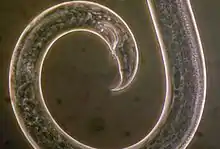Bursaphelenchus
Bursaphelenchus is a genus of nematodes (roundworms) in the order Aphelenchida. Most are obligate mycophages, but some feed on wood, with two species, the red ring nematode (B. cocophilus) and the pine wood nematode (B. xylophilus), economically significant as pests of coconut palms and of pine trees, respectively. Given that Bursaphelenchus species are usually hard to distinguish from one another except by trained nematologists with access to microscopes or DNA sequence analysis, the entire genus is put under quarantine in some countries. Where this is not the case however, these nematodes are becoming established as model organisms for nematode developmental biology, ecology and genetics.[1]
| Bursaphelenchus | |
|---|---|
 | |
| Bursaphelenchus xylophilus | |
| Scientific classification | |
| Kingdom: | |
| Phylum: | |
| Class: | |
| Subclass: | Tylenchia |
| Order: | |
| Superfamily: | Aphelenchoidoidea |
| Family: | Parasitaphelenchidae |
| Subfamily: | Bursaphelenchinae |
| Genus: | Bursaphelenchus Fuchs, 1937 |
| Species | |
|
About 70-90, see text | |
As of 2009, there are about 70[2] to 90[3] species in the genus. New taxa are described frequently.
Ecology
Bursaphelenchus contains a single described hermaphroditic species, okinawaensis, and over 100 described gonochoristic species.[4] They inhabit soil or decaying wood, feeding on the wood itself or fungal hyphae growing in it, such as those of grey mould (Botrytis cinerea). They are sometimes beneficial when they reduce the fungal load inside the wood, but when they consume the plant tissue they are known to cause the death of living trees.[1]
These nematodes are phoretic, dispersed between trees when their dauer larvae are transported by insects. Species involved include bark beetles, weevils, flat-faced longhorn beetles such as sawyer beetles, and soil-nesting bees. The process of dauer larva formation is not well understood, but it is of research interest because it is significant in the epidemics of plant diseases caused by these nematodes, such as pine wilt.[1]
Selected species
Bursaphelenchus includes:[1][5]
|
|
References
- Kanzaki, N.; et al. (2008). "First report of parthenogenesis in the genus Bursaphelenchus Fuchs, 1937: A description of Bursaphelenchus okinawaensis sp. nov. isolated from Monochamus maruokai (Coleoptera: Cerambycidae)". Zool. Sci. 25 (8): 861–73. doi:10.2108/zsj.25.861. PMID 18795821.
- Kikuchi, T.; et al. (2009). "Identification of putative expansin-like genes from the pine wood nematode, Bursaphelenchus xylophilus, and evolution of the expansin gene family within the Nematoda" (PDF). Nematology. 11 (3): 355–64. doi:10.1163/156854109x446953.
- Han, H.; et al. (2009). "First report of Bursaphelenchus pinophilus on Korean pine (Pinus koraiensis)". Plant Disease. 93 (12): 1354. doi:10.1094/pdis-93-12-1354c. PMID 30759530.
- Shinya, Ryoji; et al. (2014). "Evidence of Hermaphroditism and Sex Ratio Distortion in the Fungal Feeding Nematode Bursaphelenchus okinawaensis". G3. 4 (10): 1907–17. doi:10.1534/g3.114.012385. PMC 4199697. PMID 25122669.
- Ryss, A.; et al. (2005). "A synopsis of the genus Bursaphelenchus Fuchs, 1937 (Aphelenchida: Parasitaphelenchidae) with keys to species" (PDF). Nematology. 7 (3): 393–458. doi:10.1163/156854105774355581. hdl:10174/6709.